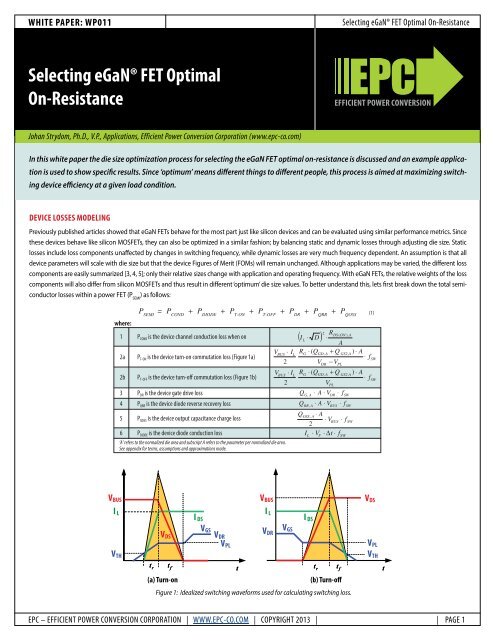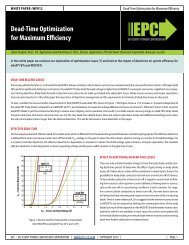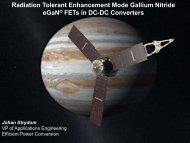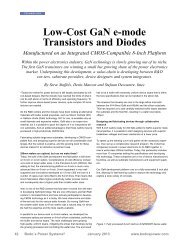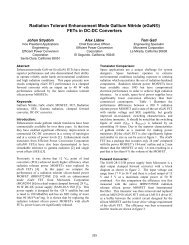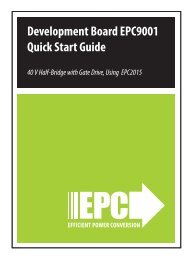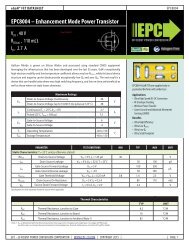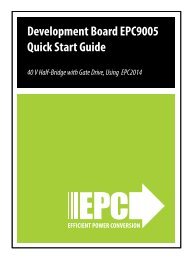application switching
Selecting eGaN® FET Optimal On-Resistance - EPC
Selecting eGaN® FET Optimal On-Resistance - EPC
- No tags were found...
Create successful ePaper yourself
Turn your PDF publications into a flip-book with our unique Google optimized e-Paper software.
WHITE PAPER: WP011<br />
Selecting eGaN® FET Optimal On-Resistance<br />
Selecting eGaN® FET Optimal<br />
On-Resistance<br />
EFFICIENT POWER CONVERSION<br />
Johan Strydom, Ph.D., V.P., Applications, Efficient Power Conversion Corporation (www.epc-co.com)<br />
In this white paper the die size optimization process for selecting the eGaN FET optimal on-resistance is discussed and an example <strong>application</strong><br />
is used to show specific results. Since ‘optimum’ means different things to different people, this process is aimed at maximizing <strong>switching</strong><br />
device efficiency at a given load condition.<br />
Device Losses Modeling<br />
Previously published articles showed that eGaN FETs behave for the most part just like silicon devices and can be evaluated using similar performance metrics. Since<br />
these devices behave like silicon MOSFETs, they can also be optimized in a similar fashion; by balancing static and dynamic losses through adjusting die size. Static<br />
losses include loss components unaffected by changes in <strong>switching</strong> frequency, while dynamic losses are very much frequency dependent. An assumption is that all<br />
device parameters will scale with die size but that the device Figures of Merit (FOMs) will remain unchanged. Although <strong>application</strong>s may be varied, the different loss<br />
components are easily summarized [3, 4, 5]; only their relative sizes change with <strong>application</strong> and operating frequency. With eGaN FETs, the relative weights of the loss<br />
components will also differ from silicon MOSFETs and thus result in different ‘optimum’ die size values. To better understand this, lets first break down the total semiconductor<br />
losses within a power FET (P SEMI<br />
) as follows:<br />
where:<br />
P SEMI<br />
= P COND<br />
+ P DIODE<br />
+ P T-ON<br />
+ P T-OFF<br />
+ P DR<br />
+ P QRR<br />
+ P QOSS (1)<br />
1 P COND is the device channel conduction loss when on<br />
2a P T-ON is the device turn-on commutation loss (Figure 1a)<br />
2b P T-OFF is the device turn-off commutation loss (Figure 1b)<br />
3 P DR is the device gate drive loss<br />
4 P QRR is the device diode reverse recovery loss<br />
5 P QOSS is the device output capacitance charge loss<br />
6 P DIODE is the device diode conduction loss<br />
‘A’ refers to the normalized die area and subscript A refers to the parameter per normalized die area.<br />
See appendix for terms, assumptions and approximations made.<br />
( I ⋅ D )<br />
2 RDS<br />
( ON ),<br />
A<br />
L ⋅<br />
A<br />
VBUS<br />
⋅ I RG<br />
⋅ ( Q<br />
L<br />
GD,<br />
A<br />
+ Q<br />
GS2,A<br />
) ⋅ A<br />
⋅ f<br />
2 VDR<br />
−VPL<br />
VBUS<br />
⋅ I R<br />
L G<br />
⋅ ( QGD,<br />
A<br />
+ Q<br />
GS2,A<br />
) ⋅ A<br />
⋅ f<br />
2<br />
VPL<br />
QG, A<br />
⋅ A ⋅ VDR<br />
⋅ fSW<br />
QRR,<br />
A<br />
⋅ A ⋅ VBUS<br />
⋅ fSW<br />
QOSS<br />
, A<br />
⋅ A<br />
⋅ VBUS<br />
⋅ fSW<br />
2<br />
I ⋅ V ⋅ ∆t<br />
⋅ f<br />
L<br />
F<br />
SW<br />
SW<br />
SW<br />
V BUS<br />
I L<br />
I L<br />
I DS<br />
I DS<br />
V GS<br />
V V DR<br />
DS<br />
VDR<br />
V PL<br />
V PL<br />
V TH<br />
t r t f t<br />
t r t f<br />
t<br />
(a) Turn-on<br />
(b) Turn-off<br />
Figure 1: Idealized <strong>switching</strong> waveforms used for calculating <strong>switching</strong> loss.<br />
Figure 1: Idealized <strong>switching</strong> waveforms used for calculating <strong>switching</strong> loss.<br />
V TH<br />
V BUS<br />
V GS<br />
EPC – EFFICIENT POWER CONVERSION CORPORATION | WWW.EPC-CO.COM | COPYRIGHT 2013 | | PAGE 1<br />
V DS
WHITE PAPER: WP011<br />
Selecting eGaN® FET Optimal On-Resistance<br />
Note that not all devices will have all these loss components, e.g. a synchronous buck converter would have practically no turn-on or turn-off losses in the synchronous<br />
rectifier. Furthermore, to optimize multiple devices in a converter, the losses stemming from the interaction between devices also need to be considered (e.g.<br />
the diode reverse recovery losses of one device may be dissipated in another FET. This occurs in circuits such as synchronous buck converters where synchronous FET<br />
related losses are dissipated in the control FET, but by optimizing the control FET only, this loss component will remain unchanged. Thus for optimization purposes,<br />
this issue is resolved by considering all the losses induced by a device to be relevant for its sizing, regardless of where the power is dissipated.<br />
Die Size Optimization<br />
By considering each of these device loss components in eq. (1) in turn, some conclusions can be drawn:<br />
• The conduction losses (item 1) are frequency independent<br />
• Commutation loss (items 2a and 2b) are both frequency and load current dependent and can be combined as follows:<br />
where:<br />
k k ON<br />
+ k OFF<br />
P<br />
k<br />
= ON<br />
V<br />
2<br />
RG<br />
=<br />
V − V<br />
BUS<br />
COMM<br />
= k ⋅QSW , A<br />
DR<br />
PL<br />
⋅ A⋅<br />
I<br />
R<br />
L<br />
⋅ f<br />
SW<br />
G<br />
k<br />
OFF<br />
= and Q<br />
SW, A<br />
= QGD,<br />
A<br />
+ QGS2, A<br />
VPL<br />
(2)<br />
• Loss components in items 3, 4 and 5 are all frequency dependent, but current independent and can be combined. While Q RR<br />
is current related, MOSFET vendors<br />
neglect to present their characteristic adequately over current, temperature and di/dt to accurately calculate these losses:<br />
(<br />
Q<br />
)<br />
2<br />
OSS,<br />
A<br />
P<br />
CHARGE<br />
= ⋅ VBUS<br />
+ Q<br />
G,A<br />
⋅ VDR<br />
+ QRR<br />
A<br />
⋅ VBUS<br />
⋅ A⋅<br />
f<br />
,<br />
SW<br />
(3)<br />
• Diode losses, item 6, are assumed die size independent (only a weak function of die size) and neglected for the optimization process.<br />
If we now define two new variables ΔI EQ<br />
and ΔI EQRR<br />
as:<br />
∆I<br />
EQ<br />
Q<br />
=<br />
OSS , A<br />
⋅ VBUS<br />
+ 2<br />
V<br />
BUS<br />
⋅ Q<br />
⋅ k ⋅ Q<br />
G,A<br />
SW,<br />
A<br />
⋅ V<br />
DR<br />
(4a)<br />
∆I<br />
EQRR<br />
=<br />
2 ⋅ Q<br />
k ⋅ Q<br />
RR,<br />
A<br />
SW , A<br />
(4b)<br />
Then combining eq. (2) and eq. (3) and substituting eq. (4a) and (4b), the <strong>switching</strong> losses are:<br />
P<br />
SW<br />
=<br />
=<br />
=<br />
[<br />
V<br />
(<br />
Q<br />
k ⋅ Q ⋅ I +<br />
2<br />
2<br />
⋅ V + Q ⋅ V + Q<br />
)]<br />
⋅ V<br />
[<br />
V<br />
V<br />
k ⋅ Q ⋅ I +<br />
2<br />
2<br />
k ⋅ Q ⋅ ( ∆I<br />
+ ∆I<br />
)]<br />
⋅ A⋅<br />
f<br />
[<br />
V<br />
2<br />
k ⋅ Q<br />
]<br />
⋅ ( I + ∆I<br />
+ ∆I<br />
) ⋅ f ⋅ A<br />
= P<br />
BUS<br />
BUS<br />
BUS<br />
SW,<br />
A<br />
⋅ A<br />
SW,<br />
A<br />
SW,<br />
A<br />
SW , A<br />
L<br />
L<br />
L<br />
OSS,<br />
A<br />
BUS<br />
EQ<br />
BUS<br />
SW,<br />
A<br />
EQRR<br />
G,A<br />
EQ<br />
SW<br />
DR<br />
EQRR<br />
RR,<br />
A<br />
BUS<br />
SW<br />
⋅ A ⋅<br />
f<br />
SW<br />
(5)<br />
EPC – EFFICIENT POWER CONVERSION CORPORATION | WWW.EPC-CO.COM | COPYRIGHT 2013 | | PAGE 2
WHITE PAPER: WP011<br />
Selecting eGaN® FET Optimal On-Resistance<br />
Thus the non-current dependent losses in eq. (3) can be modeled as an equivalent <strong>switching</strong> loss with an equivalent current ΔI EQRR<br />
for reverse recovery related losses,<br />
and ΔI EQ<br />
as the remaining charge related losses as defined in eq. (4). The Q RR<br />
related losses term can be neglected for eGaN FETs where Q RR<br />
is equal to zero, but is included<br />
for MOSFET compatibility. Thus from eq. (5) and item 1 from eq. (1), the total device losses for optimization purposes can be written as:<br />
P<br />
SEMI<br />
2 RDS<br />
( IL<br />
⋅ D )<br />
A<br />
( A)<br />
= P ⋅ A + ⋅<br />
SW,<br />
A<br />
( ON ),<br />
A<br />
(6)<br />
To find the optimum (minimum loss) point, we set the derivate to zero and calculate A:<br />
dPSEMI<br />
( A)<br />
= 0 = P<br />
dA<br />
∴ A = I<br />
L<br />
SW,<br />
A<br />
−<br />
⋅ D ⋅<br />
( I ⋅ D )<br />
L<br />
R<br />
P<br />
DS ( ON ),<br />
A<br />
SW , A<br />
2<br />
⋅<br />
R<br />
DS ( ON ),<br />
A<br />
2<br />
A<br />
(7)<br />
If we normalize all charge values to 1 Ω R DS(ON)<br />
, then the optimum device on-resistance is given by:<br />
R<br />
OPT<br />
[<br />
V<br />
]<br />
k ⋅ Q ⋅ ( I + ∆I<br />
+ ∆I<br />
) ⋅ fSW<br />
2<br />
BUS<br />
= ⋅<br />
SW,<br />
A<br />
IL<br />
D<br />
⋅<br />
1<br />
L<br />
EQ<br />
EQRR<br />
Ω<br />
(8)<br />
The normalized eGaN FET device specific parameters are given in Table 1 for a typical ‘hot’ operating temperature of 100 °C junction. Thus with eq. (8) and the values<br />
from Table 1, the optimum required die resistance can be readily calculated for a given bus voltage.<br />
Table 1: eGaN FETs normalized to 1 Ω typical R DS(ON)<br />
for difference voltage ratings.<br />
EPC – EFFICIENT POWER CONVERSION CORPORATION | WWW.EPC-CO.COM | COPYRIGHT 2013 | | PAGE 3
WHITE PAPER: WP011<br />
This process may best be explained by example, but first the decision as what<br />
load conditions are to be used for optimization must be chosen. To explain this,<br />
consider the following sets of efficiency curves for the same <strong>application</strong> shown<br />
in Figure 2.<br />
• Full Load Optimization: will result in the best full load efficiency at the cost of<br />
reduced light load and peak efficiency.<br />
• Medium Load Optimization: will result in the best medium load efficiency<br />
at the cost of full load efficiency. This is likely to result in the most ‘flat’<br />
efficiency curve.<br />
• Light Load Optimization: Best light load efficiency achieved at a significant<br />
cost of full load efficiency. May be useful where certain light load efficiency<br />
standards need to be met or minimum energy consumption standards need<br />
to be met.<br />
Efficiency (%)<br />
Selecting eGaN® FET Optimal On-Resistance<br />
100%<br />
95%<br />
90%<br />
85%<br />
80%<br />
75%<br />
70%<br />
65%<br />
Optimized For:<br />
Light Load<br />
60%<br />
Medium Load<br />
55%<br />
Full Load<br />
50%<br />
0 20 40 60 80 100<br />
% Load<br />
Figure 2: Figure Conceptual 2: Conceptual efficiency curves efficiency optimized curves for optimized<br />
difference load conditions.<br />
for difference load conditions.<br />
Thus the load current should be chosen based on where on the efficiency curve should peak (or as close as possible). This selection is complicated by the fact that the<br />
device losses are not the only current dependent circuit losses, i.e. bussing resistance and inductor DCR also increase quadratically with load current. Thus the die size<br />
optimization should be skewed towards higher dynamic losses to compensate, but with multiple devices each device can account for some arbitrary fraction of the<br />
total circuit resistance losses. If R EQ<br />
is an equivalent circuit resistance to be compensated for, then the adjusted optimum on-resistance (R OPT-ADJ<br />
) is given by:<br />
R<br />
OPT − ADJ<br />
=<br />
P<br />
I<br />
( ( ) )<br />
R R<br />
+ −<br />
P ⋅<br />
I<br />
D<br />
2 2<br />
EQ<br />
SW,<br />
A<br />
2<br />
L<br />
EQ<br />
2<br />
SW,<br />
A<br />
2<br />
L<br />
Ω<br />
(9)<br />
eGaN FET Optimization Example<br />
Consider a high frequency Buck converter with the following specifications [6]:<br />
V IN<br />
= 45 V, V OUT<br />
= 22 V, f SW<br />
= 1 MHz, I LMAX<br />
= 30 A<br />
For optimization, peak die or circuit efficiency is to be achieved at 15 A (50% load). From Table 1, we get ΔI EQ<br />
= 7.7 A, ΔI EQRR<br />
= 0 A, k = 1.44 /A and Q SW,A<br />
= 28 pF / Ω (using<br />
the 48 V). Also needed are D = 22/45 = 0.49 and I L<br />
= 15A.<br />
For the adjusted optimum on-resistance a total equivalent circuit resistance of 8 mΩ is estimated from [6]. Since the high-side control FET losses dominate total device<br />
losses, lets arbitrarily choose 7 mΩ of this be compensated for in the high-side. Since equivalent resistance losses are compensated by increasing <strong>switching</strong> losses, it<br />
makes sense to compensate most (if not all) of these losses in the device with higher <strong>switching</strong> loss.<br />
A) Control FET optimization<br />
For the control FET, the on-state duty cycle is ‘D’, there are no Q RR<br />
losses, but there are Q OSS<br />
and hard <strong>switching</strong> losses. Thus from eq. (9) we get:<br />
R<br />
R<br />
OPT<br />
OPT<br />
1<br />
( 100°<br />
C)<br />
=<br />
15A⋅<br />
1<br />
( 100°<br />
C)<br />
=<br />
15A⋅<br />
0. 49<br />
0. 49<br />
⋅<br />
⋅<br />
[<br />
45V<br />
]<br />
1. 4 4/ A⋅<br />
28pF<br />
/ Ω ⋅ ( 15A<br />
+ 7.7A<br />
+ 0A<br />
2<br />
)<br />
0.0206WΩ<br />
= 14.1mΩ<br />
⋅1MH<br />
thus R OPT<br />
(25°C) = ~9.7 mΩ typical<br />
EPC – EFFICIENT POWER CONVERSION CORPORATION | WWW.EPC-CO.COM | COPYRIGHT 2013 | | PAGE 4
WHITE PAPER: WP011<br />
Selecting eGaN® FET Optimal On-Resistance<br />
Considering the equivalent circuit resistance, the adjusted optimum on-resistance is from eq. (9)<br />
R<br />
thus R OPT-ADJ<br />
(25°C) = ~5.7 mΩ typical<br />
( 100°<br />
C)<br />
=<br />
0.0206WΩ<br />
/ 15A<br />
( )<br />
7mΩ<br />
+ + 0.0206WΩ<br />
⋅ 0. 4 9 /( 15A)<br />
2<br />
(<br />
7mΩ)<br />
2<br />
OPT − ADJ<br />
8.3<br />
2<br />
2<br />
2<br />
=<br />
mΩ<br />
B) Synchronous FET optimization<br />
For the synchronous FET, the load current I L<br />
at <strong>switching</strong> is taken as zero, while there are no turn-on or turn-off commutation losses in the synchronous FET, Q OSS<br />
induced losses and Q RR<br />
losses are present (zero for eGaN FET). Also the on-state duty cycle is ‘1-D’. Thus from eq. (9) we get:<br />
thus R OPT<br />
(25°C) = ~5.2 mΩ typical<br />
R<br />
OPT<br />
1<br />
( 100°<br />
C)<br />
=<br />
⋅<br />
15A⋅<br />
0. 51<br />
1<br />
ROPT<br />
( 100°<br />
C)<br />
=<br />
15A⋅<br />
[<br />
45V<br />
]<br />
1. 44/<br />
A ⋅ 28pF/<br />
Ω ⋅ ( 0A<br />
+ 7.7A<br />
+ 0A<br />
)<br />
2<br />
0. 51<br />
⋅<br />
0. 007WΩ = 7.6mΩ<br />
⋅1MH<br />
Considering the equivalent circuit resistance, the adjusted optimum on-resistance is from eq. (9) for the remaining 1 mΩ:<br />
thus R OPT-ADJ<br />
(25°C) = ~4.3 mΩ typical<br />
( )<br />
1mΩ<br />
+ + 0. 007W<br />
Ω ⋅0.51/ ( 15A<br />
)<br />
2<br />
(<br />
1mΩ<br />
) 2<br />
( 1 A)<br />
0. 007WΩ<br />
/ 5<br />
ROPT − ADJ<br />
( 100°<br />
C)<br />
=<br />
= 6.2mΩ<br />
2<br />
2<br />
2<br />
As can be seen from this example, the optimum on-resistance changes significantly for any large (same range as the device on-resistances) additional circuit resistance<br />
being compensated for. Obviously, these additional circuit losses could be minimized prior to compensation and any such additional optimization adjustment would<br />
be minor. To see the impact of adjusting for some of the equivalent circuit resistance, the control FET and synchronous FET optimum resistance are plotted versus load<br />
current for this same example in Figures 3 and 4 respectively.<br />
Experimental Results<br />
To evaluate the validity of this optimization approach, some experimental efficiency curves were taken for the same buck converter used in the example above [6]. The<br />
same circuit was built and only the EPC devices were changed, as outlined in Table 2, using various combinations of the EPC2001 [7] and EPC2016 [8] eGaN FETs. The<br />
efficiency and power loss curves as function of load current for these three cases are plotted and shown in Figure 5. Their estimated optimized points are color coded<br />
and added as dots to Figures 3 and 4. Table 2 shows good correlation between the adjusted on-resistance and actual current levels at peak efficiency.<br />
Optimization comparison with MOSFETs<br />
To see how this optimization process compares when using MOSFETs, it is necessary to find representative high performance MOSFETs and normalize them in a similar<br />
manner. The resultant values are given in the appendix, Table 3 for reference. Using the same design example as before, the resultant optimum on-resistance values for<br />
the control and sync FETs are plotted versus load current in Figures 6 and 7 respectively. The reverse recovery losses (Q RR ) for these MOSFETs taken from the datasheets<br />
are rather large and could be mitigated by the addition of a freewheeling Schottky diode. Therefore the resultant MOSFET on-resistance, neglecting Q RR , losses is also<br />
shown in Figure 7. This clearly shows the similarity between eGaN FETs and MOSFETs and shows that an optimal eGaN FET would in all cases have a lower resistance<br />
than a similarly optimized MOSFET device. This results from the reduced dynamic losses offered by the eGaN FET due to its lower FOM [1].<br />
EPC – EFFICIENT POWER CONVERSION CORPORATION | WWW.EPC-CO.COM | COPYRIGHT 2013 | | PAGE 5
WHITE PAPER: WP011<br />
Selecting eGaN® FET Optimal On-Resistance<br />
100<br />
100<br />
Adjusted Optimum Die Resistance (mΩ)<br />
10<br />
0 mΩ R EQ<br />
2 mΩ R EQ<br />
5 mΩ R EQ<br />
10 mΩ R EQ<br />
93.0%<br />
EPC 2016<br />
EPC 2001<br />
Adjusted Optimum Die Resistance (mΩ)<br />
10<br />
EPC 2016<br />
EPC 2001<br />
0 mΩ R EQ<br />
2 mΩ R EQ<br />
5 mΩ R EQ<br />
10 mΩ R EQ<br />
0 5 10 15 20 25 30 35<br />
Load Current (A)<br />
Figure 3: Adjusted optimum on-resistance (25 °C) for the control FET for a<br />
45 Figure V to 22 3: Adjusted V / 1 MHz optimum buck converter on-resistance for varying (25 values °C) for of equivalent the control circuit FET for resistance a 45 V R EQ .<br />
to 22 V / 1 MHz Solid buck circles converter represent for varying experimental values test of equivalent cases from Table circuit 2. resistance<br />
REQ. Solid circles represent experimental test cases from Table 2.<br />
0 5 10 15 20 25 30 35<br />
Load Current (A)<br />
Figure 4: Adjusted optimum on-resistance (25 °C) for the synchronous FET for a<br />
45 Figure V to 22 4: V Adjusted / 1 MHz buck optimum converter on-resistance for varying (25 values °C) of for equivalent the synchronous circuit resistance FET for R EQ .<br />
a 45 V to 22 V Solid / 1 MHz circles buck represent converter experimental for varying test values cases from of equivalent Table 2. circuit<br />
resistance REQ. Solid circles represent experimental test cases from Table 2.<br />
Table 2: Experimental test cases and calculated optimum on-resistances<br />
98.0%<br />
97.5%<br />
97.0%<br />
96.5%<br />
10<br />
9<br />
8<br />
7<br />
Efficiency (%)<br />
96.0%<br />
6<br />
95.5%<br />
5<br />
95.0%<br />
4<br />
94.5%<br />
Efficiency<br />
Power Loss<br />
3<br />
94.0%<br />
EPC2016 x 2<br />
EPC2016 x 2<br />
2<br />
EPC2016, EPC2001<br />
EPC2016, EPC2001<br />
93.5%<br />
EPC2001 x 2<br />
EPC2001 x 2<br />
1<br />
0<br />
0 2 4 6 8 10 12 14 16<br />
Output Current (A)<br />
Power Loss (W)<br />
Figure 5: Efficiency and loss curves for different eGaN FETs per Table 2, 45 V IN , 22 V OUT , 1 MHz.<br />
Figure 5: Efficiency and loss curves for different eGaN FETs per Table 2,<br />
45 V IN , 22 V OUT , 1 MHz.<br />
EPC – EFFICIENT POWER CONVERSION CORPORATION | WWW.EPC-CO.COM | COPYRIGHT 2013 | | PAGE 6
WHITE PAPER: WP011<br />
Selecting eGaN® FET Optimal On-Resistance<br />
Effect of Package and Layout on Optimization<br />
It has been shown [9, 10, 11] that common source inductance (CSI) will significantly<br />
increase <strong>switching</strong> loss for hard <strong>switching</strong> devices. Equations for the<br />
estimation of this increase are complex and somewhat varied. This loss increase,<br />
although significant has also been shown to be die size independent<br />
for a given device technology [12] and therefore has little impact on die size<br />
optimization process. For eGaN FETs in practice, however, the CSI would be a<br />
weak function of die size as all the wafer level chip-scale package (WLCSP) inductances<br />
will scale with die size, but this complexity is beyond the scope of<br />
this paper. Such an inverse relationship between CSI and die size means that<br />
some small portion of <strong>switching</strong> losses actually decreases with increasing die<br />
size, even though this may seems counter intuitive.<br />
Optimum Die Resistance (mΩ)<br />
100<br />
10<br />
eGaN FET<br />
MOSFET<br />
Summary<br />
Using the simple optimization method presented here is a quick way to find the<br />
optimum eGaN FET on-resistance value. As with many simple solutions, the accuracy<br />
is limited and the actual optimum resistance may deviate. Furthermore,<br />
the optimum combination of die size and on-resistance is also a function of<br />
the non-device related equivalent circuit conduction resistance. This paper<br />
presents a method for optimization that compensates for these additional current-dependent<br />
losses. Experimental results show good agreement through<br />
accurate predictions of load current at peak efficiency.<br />
Since eGaN FETs will always optimize to a lower on-resistance than MOSFETs,<br />
the overall peak efficiency will therefore be higher (total conduction and<br />
<strong>switching</strong> losses equal at peak) than MOSFETs (given the assumptions made).<br />
If the same on-resistance is used, the eGaN FET efficiency will peak at a lower<br />
current.<br />
Optimum Die Resistance (mΩ)<br />
100<br />
10<br />
0 5 10 15 20 25 30 35<br />
Load Current (A)<br />
Figure 6: Optimum on-resistance (25 °C) for the control FET (high side)<br />
Figure 6: Optimum on-resistance (25 °C) for the control FET (high side)<br />
for a 45 V to 22 V / 1 MHz buck converter.<br />
for a 45 V to 22 V / 1 MHz buck converter.<br />
eGaN FET<br />
MOSFET - Q RR<br />
MOSFET<br />
0 5 10 15 20 25 30 35<br />
Load Current (A)<br />
Figure 7: Optimum on-resistance (25 °C) for the synchronous FET (low side)<br />
Figure 7: Optimum on-resistance (25 °C) for the synchronous FET (low side)<br />
for a 45 V to 22 V / 1 MHz buck converter.<br />
for a 45 V to 22 V / 1 MHz buck converter.<br />
References:<br />
[1] J. Strydom, “eGaN® FET-Silicon Power Shoot-Out Part 1: Comparing Figure of Merit (FOM)”, Power Electronics Technology, Sept. 2010,<br />
http://powerelectronics.com/power_semiconductors/power_mosfets/fom-useful-method-compare-201009/<br />
[2] J. Strydom, “The eGaN FET-Silicon Power Shoot-Out: 2: Drivers, Layout”, Power Electronics Technology, Jan. 2011,<br />
http://powerelectronics.com/power_semiconductors/first-article-series-gallium-nitride-201101/<br />
[3] Jon, Klein, “Synchronous buck MOSFET loss calculations with Excel model”, Fairchild Semiconductor, App. note AN-6005, http://www.fairchildsemi.com/an/AN/AN-6005.pdf<br />
[4] Jon Gladish, “MOSFET Selection to Minimize Losses in Low-Output-Voltage DC-DC Converters”, Fairchild Semiconductor Power Seminar 2008 – 2009.<br />
[5] “Properly Sizing MOSFETs for PWM Controllers”, Sipex App. note ANP-20, http://www.exar.com/common/content/document.ashx?id=1245<br />
[6] J. Strydom, “eGaN® FET- Silicon Power Shoot-Out Volume 8: Envelope Tracking”, Power Electronics Technology, Apr. 2012,<br />
http://powerelectronics.com/power_semiconductors/gan_transistors/egan-fet-silicon-power-shoot-out-volume-8-0430/<br />
[7] EPC2001 datasheet, EPC Corporation, http://epc-co.com/epc/Products/eGaNFETs/EPC2001.aspx<br />
[8] EPC2016 datasheet, EPC Corporation, http://epc-co.com/epc/Products/eGaNFETs/EPC2016.aspx<br />
[9] D. Jauregui, B. Wang, R. Chen, “Power Loss Calculation with Common Source Inductance Consideration for Synchronous Buck Converters”, Texas Instruments, SLPA009A, June 2011,<br />
http://www.ti.com/lit/an/slpa009a/slpa009a.pdf<br />
[10] W. Eberle, Z. Zhang, et. al, “A Practical Switching Loss Model for Buck Voltage Regulators”, IEEE Transactions on Power Electronics, Vol. 24, No. 3, March 2009.<br />
[11] T. Hashimoto, M. Shiraishi, et. al, “System in Package (SiP) With Reduced Parasitic Inductance for Future Voltage Regulator”, IEEE Transactions on Power Electronics, Vol. 24, No. 6, June 2009.<br />
[12] Y. Ying, “Device Selection Criteria - Based on Loss Modeling and Figure of Merit”, M.Sc. Thesis, Virginia Tech, http://scholar.lib.vt.edu/theses/available/etd-05272008-143141/<br />
EPC – EFFICIENT POWER CONVERSION CORPORATION | WWW.EPC-CO.COM | COPYRIGHT 2013 | | PAGE 7
WHITE PAPER: WP011<br />
Selecting eGaN® FET Optimal On-Resistance<br />
Appendix<br />
R DS(ON),A On state resistance at 100 °C normalized for a die area taken as 1 Ω. All other device parameters are normalized with respect to this.<br />
R G<br />
V BUS<br />
I L<br />
D<br />
f SW<br />
V PL<br />
V DR<br />
Q GD,A<br />
Q GS2,A<br />
Q G,A<br />
Q SW,A<br />
Q OSS,A<br />
Q RR,A<br />
Resistance of gate drive path – either pull-up or pull-down as needed. This includes a 2 Ω pull-up and a 0.5 Ω pull down driver resistance (that is die size<br />
independent) and 0.6 Ω internal eGaN FET gate resistance. This number tends to be die size independent as smaller die have both shorter and narrower<br />
effective gate traces. For MOSFETs, the datasheet value is used and also assumed die size independent.<br />
The DC bus voltage that the <strong>switching</strong> node sees during operation. e.g. Input voltage for a Buck and output voltage for a Boost.<br />
This is the average inductor current and/or switch current during the switch on-state. Ripple is neglected such that the same value can be used throughout.<br />
Device on-time duty cycle is the fraction of the total cycle for with the device being optimized is conducting.<br />
This refers to the frequency at which the eGaN FET or MOSFET is <strong>switching</strong>.<br />
The plateau voltage of a device at rated current. Although this value may vary significantly with load, it is assumed constant during optimization for simplicity.<br />
Gate drive voltage<br />
Miller charge per normalized die area. This is assumed constant for a given bus voltage and calculated from the datasheet values and related charge graph.<br />
Gate charge between device threshold and plateau voltage per normalized die area. This is constant for a given load current and calculated from the datasheet<br />
value at rated current.<br />
Total normalized gate charge at given device drive voltage calculated from datasheet.<br />
Total normalized <strong>switching</strong> charge from reaching threshold to end of plateau.<br />
Total normalized device output charge a given bus voltage and calculated from the datasheet values and related charge graph.<br />
Total normalized device diode reverse recovery charge taken from the MOSFET datasheets.<br />
V F<br />
Forward drop of the device diode carrying a current I L<br />
.<br />
Δt<br />
k ON<br />
k OFF<br />
Total diode conduction interval per <strong>switching</strong> cycle.<br />
The inverse of the gate current during device turn-on ; assumed constant for optimization.<br />
The inverse of the gate current during device turn-off; assumed constant for optimization.<br />
Assumptions and approximations<br />
• Common source inductance (CSI) related increase in <strong>switching</strong> loss is discussed separately, but neglected for optimization purposes.<br />
• Temperature dependence of on-resistance is considered. All values are optimized based on ‘typical’ datasheet values at 100 °C. To determine the equivalent 25 °C<br />
values, the final optimized on-resistance value has to be normalized back to 25 °C.<br />
• Q OSS<br />
losses assume one <strong>switching</strong> edge is ZVS and one is ‘hard’ <strong>switching</strong>, i.e. the Q OSS<br />
energy is lost at device turn-on or turn-off only.<br />
• Q GS2<br />
varies with current at turn-on/off, but the value used is taken from the data sheet at rated current – thus will overestimate this component for lighter loads. It<br />
has a smaller impact at higher voltages as shown below. Also the gate drive current for this interval is calculated using the same plateau voltage, thereby overestimating<br />
turn-on time and under estimating turn-off.<br />
40 V 40 V 100 V 200 V<br />
V BUS 12 V 24 V 48 V 100 V<br />
Q GS2,A<br />
Q<br />
GD , A<br />
@ rated I DS 3.5 pC / Ω 3.5 pC / Ω 5 pC / Ω 9 pC / Ω<br />
@ V BUS 6 pC / Ω 7 pC / Ω 14 pC / Ω 35 pC / Ω<br />
Q GD /(Q SW ) 6/9.5 =0.63 7/10.5 =0.67 14/19 = 0.73 35/42 = 0.83<br />
Error of Q SW with varying load current 0 to 37% 0 to 33% 0 to 27% 0 to 17%<br />
EPC – EFFICIENT POWER CONVERSION CORPORATION | WWW.EPC-CO.COM | COPYRIGHT 2013 | | PAGE 8
WHITE PAPER: WP011<br />
Selecting eGaN® FET Optimal On-Resistance<br />
• Diode losses will vary with die size, but this variation is neglected for the optimization process for simplicity. The diode losses will vary inversely to other charge<br />
dependent losses with die size (will actually get smaller with increased die size), but this variation is assumed small in comparison to that of the charge dependent<br />
losses.<br />
• The current at turn-on and turn-off are assumed equal and the influence of inductor current ripple is ignored. To quantify the error of doing so, consider turn on at<br />
I L<br />
-I P<br />
and turn off at I L<br />
+I P<br />
, then the turn-on/off losses are:<br />
[<br />
V ⋅ ( I + I ) V ⋅ ( I<br />
k +<br />
2<br />
2<br />
− I )<br />
k<br />
]<br />
⋅Q<br />
⋅ A ⋅ f<br />
[<br />
V ⋅ ( I ) V ⋅ ( I ) V ⋅ ( I ) V ⋅ ( I<br />
= k + k + k −<br />
2<br />
2<br />
2<br />
2<br />
)<br />
k<br />
]<br />
[<br />
V ⋅ ( I ) V ⋅ ( I ) ( )<br />
]<br />
= k + k − k ⋅Q<br />
⋅ A ⋅ fSW<br />
2<br />
2<br />
BUS<br />
BUS<br />
BUS<br />
L<br />
L<br />
L<br />
P<br />
ON<br />
ON<br />
BUS<br />
BUS<br />
BUS<br />
P<br />
L<br />
L<br />
ON<br />
OFF<br />
P<br />
OFF<br />
OFF<br />
BUS<br />
P<br />
SW , A<br />
SW , A<br />
ON<br />
SW<br />
BUS<br />
P<br />
OFF<br />
⋅ Q<br />
SW , A<br />
⋅ A⋅<br />
f<br />
SW<br />
So the error is an underestimation for eGaN FETs:<br />
I<br />
p<br />
( kON<br />
kOFF)<br />
I<br />
L<br />
⋅ k<br />
≈<br />
1<br />
3<br />
I<br />
I<br />
p<br />
L<br />
≈<br />
1<br />
6<br />
I<br />
I<br />
pp<br />
L<br />
for a peak to peak ripple = 30%, then error = 5% (even smaller for MOSFET, where k ON<br />
and k OFF<br />
values are almost equal.<br />
• Error for soft-<strong>switching</strong> devices where Q G<br />
is used on driver loss and incorrectly includes Q GD<br />
. This error, Q GD<br />
/Q G<br />
is about 30% over estimation of soft <strong>switching</strong> gate<br />
drive losses.<br />
Table 3: State of the art MOSFETs normalized to 1 Ω typical R DS(ON)<br />
for difference voltage ratings<br />
EPC – EFFICIENT POWER CONVERSION CORPORATION | WWW.EPC-CO.COM | COPYRIGHT 2013 | | PAGE 9


